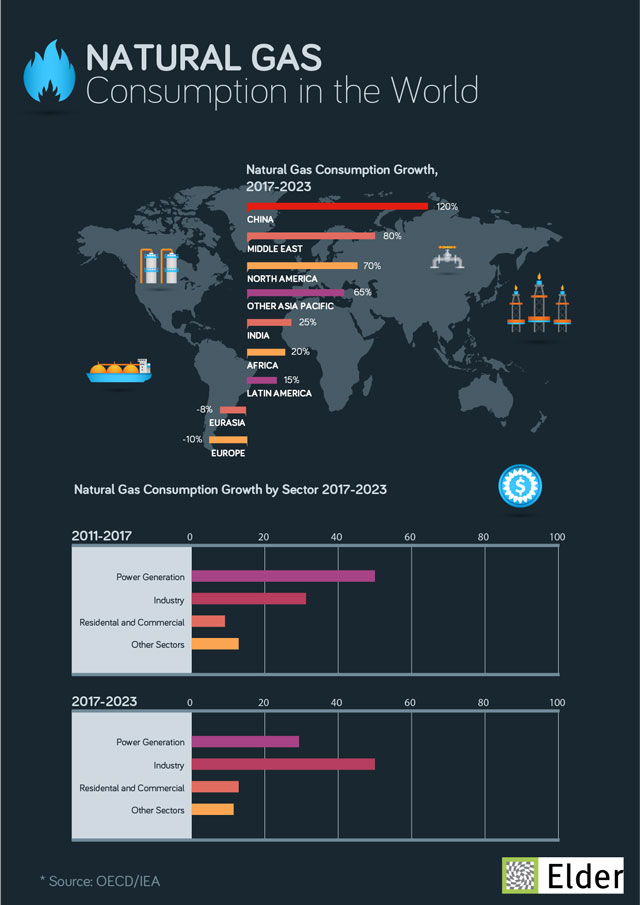
Turkish President Recep Tayyip Erdogan and his Russian counterpart Vladimir Putin on Saturday discussed two energy cooperation projects in a phone call, according to Turkish presidential sources. They discussed TurkStream, a gas pipeline under construction from Russia to Turkey, and Akkuyu nuclear power plant, located in Turkey's southern Mersin province.
The first line of the TurkStream, which will send around 15.75 billion cubic meters of natural gas from Russia to Turkey was completed in April. The second line with the same capacity as the first line will send gas to Europe through Turkey.
The Akkuyu nuclear power plant will boast four reactors, each with a capacity of 1,200 megawatts, and will be built by the Russian state nuclear energy agency Rosatom. Putin and Erdogan expressed their satisfaction on energy cooperation between the two countries, said the sources who spoke on condition of anonymity due to restrictions on talking to the media.
The two leaders also agreed to meet face-to-face at BRICS Summit in Johannesburg which will be held in the end of July, sources added. Following peace talks held last year in Kazakh capital Astana, Daraa was designated a “de-escalation zone” in which acts of aggression are expressly prohibited.
Syria has only just begun to emerge from a devastating conflict that began in 2011 when the Assad regime cracked down on demonstrators with unexpected ferocity.
Source: AA

Turkey's electricity sector allocated around $23 billion for electricity distribution and privatization over the last 10 years, according to Serhat Cecen, the head of Turkey's Electricity Distribution Services Association (ELDER) on Thursday.
In an exclusive interview with Anadolu Agency, Cecen said that $13 billion was used for distribution and retail while $10 billion was allocated for the privatization of production facilities.
He explained that loans covered 80 percent of the total amount for privatization while equities met the remaining 20 percent.
"All of this amount was used in U.S. dollar-based loans from Turkish banks," he said, but asserted that despite the current strong dollar rate, the loans would be managed in close cooperation with the loan-issuing banks.
Cecen said that over the coming years electricity production from domestic and renewable resources would increase and that plans are afoot to develop the country's electricity infrastructure to increase service quality and customer satisfaction.
$100 billion investment in 10 years
The private sector invested $95 billion in the Turkish electricity sector in the last few years, Cecen said, adding that "$77 million was used for production facilities and the rest was used for the distribution network."
He added that the state contributed $5 billion for distribution towards a total investment of $100 billion. "These investment figures are the biggest in Turkey's history," he stressed. He also shared ELDER's aim to digitally transform the energy sector.
"With these steps [via digitization], with every passing year, Turkey will become a self-sustained country in energy," he said, and added that Turkey can eventually export energy produced from renewable sources.
Source: Anadolu Agency
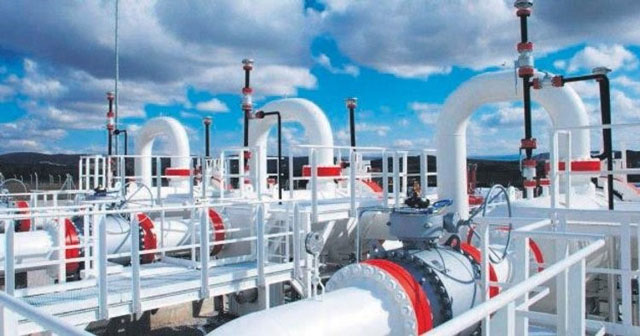
Turkey, which has emerged as a leader in the energy sector, has completed its work to establish a natural gas energy stock exchange that will start trading operations on Sept. 1. Aiming to become a natural gas trading hub with this step, Turkey will also play an active role in pricing.
Having taken important steps of being an energy hub in the region with the Trans-Anatolian Natural Gas Pipeline (TANAP), which recently brought Azerbaijani gas to Turkey, and the oil-gas explorer vessel Fatih, Turkey is now establishing a natural gas energy stock exchange. With the natural gas market actively commissioned, an important step will be taken towards the pricing of natural gas at accessible markets and Turkey's goal of becoming a regional natural gas trading hub.
The Energy Market Regulatory Authority (EMRA) has recently updated the Organized Natural Gas Wholesale Market Operation Procedures and Principles (PUE), which can be regarded as the rules of trade in the natural gas stock exchange, are an important step in the direction of Turkey's goal in becoming a natural gas trade center in the region.
The natural gas stock exchange, called the Natural Gas Continuous Trading Platform (STP), was launched virtually on April 1, 2018. During the virtual application, the system was heavily tested by natural gas supply license holders. In addition, under the supervision of EMRA, scenario studies were carried out with Petroleum Pipeline Corporation (BOTAŞ) and Turkey's Energy Stock Exchange (EPİAŞ) and contracts were drafted. In accordance with the purpose of the virtual application, some problems encountered during these studies and other issues identified, necessitated the revision of some of PUE's articles. BOTAŞ, EPİAŞ and market players' views were taken, and the issue was taken to board in order for the stock market to operate in a healthy and smooth manner.
With this last amendment, the rules of trade and the rights and obligations of the parties that will carry out transactions in this platform will be clarified in order to ensure that the stock exchange, which will commence formal operations on September 1, 2018, can operate smoothly. The platform, to be operated by EPİAŞ, will be used by natural gas suppliers and exporters who want to trade natural gas, as well as BOTAŞ to supply natural gas to balance the transmission system. The trading on the stock exchange will be 24 hours a day, 365 days a year, and also provide the foundation for the Daily Reference Price (DRP).
With the decision of EMRA, the Protocol on Reconciliation of Imbalances and transaction fees for the Reconciliation of Imbalances were defined within the scope of the regulations made for the natural gas market, while arrangements were made to prevent market participants from matching their offers. In addition, the imbalance charges determined within the natural gas transmission network operation regulations were added to the formulas, and additions were made to the definitions of transaction limits.
Financial matters, billing, advances, payments, notifications of insolvency were added in this regard, along with the resulting arrangements for the formulas in the simulation process.
Source: Daily Sabah

Murat Pınar, General Manager of Enerjisa Distribution Companies, has been elected to the chairmanship of the EUROGIA2020 Group, operating under the roof of EUREKA, which the European Union has established for the development of new technologies and projects. Putting into practice innovative investments in the industry in terms of energy efficiency and sustainability, Enerjisa Distribution Companies will decide which R&D projects will shape the future of energy in Europe by means of this important position undertaken by Murat Pınar.
EUROGIA Chairman Murat Pınar stated that, what is important is to serve for the industry by taking part in this community, not the titles. Pınar said: "EUROGIA2020 Community, which is the locomotive of R&D activities in the energy field in the European Union, plays an essential role in shaping the future. During my chairmanship, bringing successful R&D practices from abroad to our country will be one of our most important goals. As Turkey, we should not only be the followers but the pioneer in R&D field. As before, we will continue our work and projects during my chairmanship period as well."
About EUROGIA2020
EUROGIA2020, which supports the cooperation of international companies on the development of 'Low Carbon Energy Technologies', works on facilitating the deployment of existing technologies and support the development of innovative technical solutions.
EUROGIA2020, an international organization funded by 40 countries, mainly European Union countries, and adopted at the intergovernmental level, carries out its operations with stakeholders consisting of SMEs, public research centers, universities and international companies. Projects approved by EUROGIA2020 since 2008 represent a total budget of 250 million Euros. Since 2013, Turkey has been the country with the largest number of projects presented to EUROGIA2020.
The EUROGIA2020 Community focuses on R&D projects such as developing various clean energy sources, improving energy efficiency in all consumer and industrial implementations, meeting the growing fossil fuel needs of the world, and establishing a sustainable and effective energy system within the interaction between technology and society.
EUROGIA2020 is supported by Turkey, Austria, Canada, Croatia, Czech Republic, Estonia, France, Germany, Greece, Hungary, Iceland, Israel, Monaco, Netherlands, Norway, Poland, Spain, South Africa and UK.
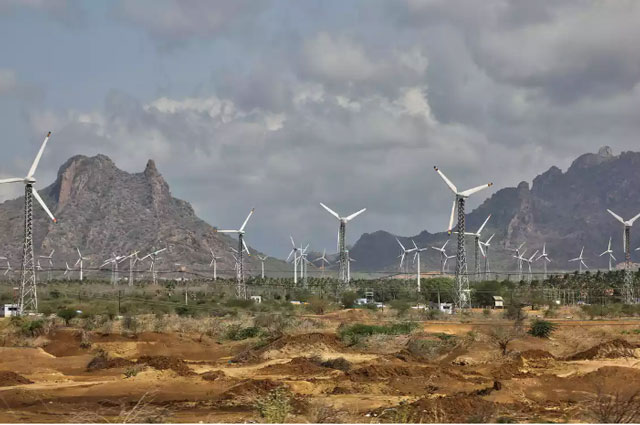
The world’s energy watchdog has sounded the alarm over a “worrying” pause in the shift to clean energy after global investment in renewables fell 7% to $318bn (£240bn) last year.
The International Energy Agency said the decline is set to continue into 2018, threatening energy security, climate change and air pollution goals. Fossil fuels increased their share of energy supply investment for the first time since 2014, to $790bn, and will play a significant role for years on current trends, the IEA said.
Investment in coal power dropped sharply but was offset by an uptick in oil and gas spending, the World Energy Investment report found.
Dr Fatih Birol, the executive director of the IEA, said of the renewables fall: “We are seeing a decrease, which is disappointing. And more disappointing is we see the signs this decline may decline this year – this is a worrying trend.”
Fossil fuels’ share of energy investment needs to drop to 40% by 2030 to meet climate targets but instead rose fractionally to 59% in 2017.
World leaders’ warm words on renewables and energy efficiency needed to be matched with action, Birol said, urging governments to create less investment uncertainty for green energy.
“I was myself worried to see there is a contradiction between a) the statements the governments make and b) what the world needs today vis-a-vis the investment numbers, where we see a decline,” he said.
Globally, energy investment fell 2% to $1.8tn in 2017, with electricity taking a bigger share than oil and gas for the second year in a row.
The decline in renewable power generation spending was mostly down to falls in wind power and hydro but despite becoming cheaper to install.
While coal investment fell to its lowest level in 10 years, spending on gas-fired power stations rose 40%. Nuclear power fell sharply to the lowest level of investment in five years.
In the oil and gas industry, rising prices have helped investment in production rise 4% last year and is expected to grow 5% this year. The US’s will drive much of the growth, and frackers are on track to achieve positive free cashflow this year, for the first time.
The US is not expected to pump enough extra crude to bring down oil prices, though. Birol said: “US shale growth is very welcome growth for badly needed additions but this growth alone will not be enough to balance out the markets.”
Outside the US, investment in conventional oil and gas projects remains subdued and Birol said the world faced “major difficulties” if investment was not stepped up.
Motorists spent $43bn on fully electric cars and plug-in hybrids last year, accounting for half of global growth in car sales. However, the battery-powered cars are not seriously denting oil demand yet, the IEA said.
Governments are increasing investment in energy markets, either directly through state-owned firms or indirectly via investments policies and regulation, which Birol said was a surprising development.
Source: The Guardian

Climate discussions typically center on the need to replace fossil-fuel power plants with technologies like wind turbines and solar panels.
But a new paper in Science offers a stark reminder that there are still huge parts of the global energy system where we simply don’t have affordable ways of halting greenhouse-gas emissions.
Air travel, long-distance transportation and shipping, steel and cement manufacturing, and remaining parts of the power sector account for 27 percent of global emissions from the energy and industrial sectors. And the authors say we need much more research, innovation, and strategic coordination to clean up these sources.
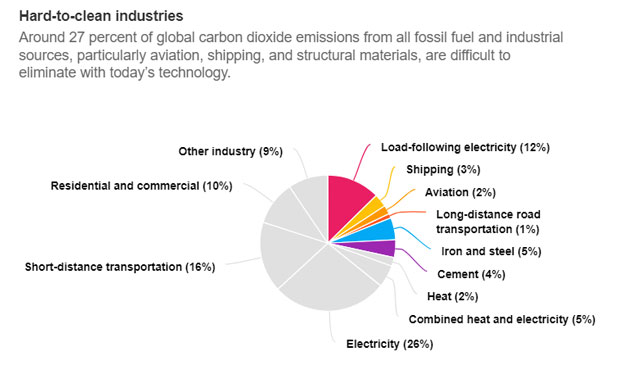
“If we’re really ambitious about meeting our climate targets, we need to be tackling these hard sectors now,” says the paper’s lead author, Steven Davis, an earth system scientist at the University of California, Irvine. (The more than 30 prominent coauthors include Sally Benson at Stanford, Ken Caldeira at the Carnegie Institution, Nathan Lewis of the California Institute of Technology, and Jessika Trancik and Yet-Ming Chiang at MIT.)
Aviation, trucking and shipping
The declining cost and improving performance of lithium-ion batteries and hydrogen fuel cells has made it possible to begin cleaning up big portions of the transportation industry, including cars, light-duty trucks, and short-haul semis.
But batteries and fuel cells are still too heavy and expensive for long-distance hauling and shipping, as well as the vast majority of air travel. For these, the authors conclude, liquid fuels are likely to remain the preferred energy source, given the amount of energy that can be packed into a given weight and volume.
The researchers survey a range of solutions, including hydrogen or ammonia fuels, advanced biofuels, synthetic fuels, and solar fuels produced using what are known as artificial leaves (see “The race to invent the artificial leaf”). But none of these can be generated anywhere near as inexpensively as a standard gallon of gasoline or diesel.
The researchers note that this area could demand special priority in research and development efforts. Such technologies could also provide a form of long-term energy storage for renewable sources like solar and wind, providing a crucial missing piece in the electricity sector as well.
Cement and steel
Producing two of the world’s most common building materials, steel and cement, also generates considerable carbon dioxide. Carbon is used to reduce iron ore in the process of creating steel, while producing cement involves decomposing calcium carbonate using high heat, which generates emissions as well.
In both cases, this pollution could be reduced by adding systems that capture carbon before it’s released from the plants, as well as by shifting to different practices entirely. Cleaning up cement, for instance, may require switching to new materials that can actually capture and sequester carbon dioxide (see “What happened to green concrete?”).
But here again, the question is cost. Much of the global production of steel and cement occurs in poor parts of the world, where it’s especially hard to make the case for expensive upgrades or overhauls of legacy plants that can ordinarily operate for decades.
“Load-following” electricity
Renewable energy sources like wind and solar are providing a growing proportion of electricity, but the critical challenge has been that power generation plummets when the sun isn’t shining and the wind isn’t blowing. Operating a dependable grid thus requires leaning on other power plants that can quickly ramp production up and down to meet demand, a “load-following” job that’s increasingly fallen to carbon-spewing natural-gas plants.

The authors conclude that addressing this challenge without adding greenhouse emissions will require better carbon capture systems, more flexible nuclear plants, cheaper forms of large-scale energy storage, and various tools and incentives that can encourage residents and businesses to shift their electricity usage to times of peak production.
Notably, the paper surveyed only the parts of the energy and industrial systems where we lack affordable tools to eliminate greenhouse-gas pollution today. Among other challenges, the world also needs to figure out ways to significantly reduce the emissions produced from agriculture and land-use changes like deforestation. And, of course, we need to begin scaling up the technologies we do have available to clean up the electricity sector at a much faster rate.
Source: MIT Technology Review

The UK’s world-leading aerospace sector will be propelled into a new era of cleaner, greener flight through industry and government investment, the Business and Energy Secretary announced at the 2018 Farnborough International Airshow.
From the total investment, £255 million, supported by the Aerospace Technology Institute (ATI) and UK Research & Innovation (UKRI), will go towards 18 new research and technology projects, including the development of cleaner and greener hybrid aircraft.
To support small and medium-sized companies, £68 million of the funding will be made available to increase research and development opportunities, with £20 million to drive improvements in long-term productivity across the sector.
The projects will not only help maintain the UK’s existing strengths in aerospace but also position the UK as a world leader for some of the most technologically advanced aircraft that will transform the face of aviation including electric aircraft, hybrid-electric propulsion systems, and future materials for aircraft manufacturing.
A major beneficiary of the latest research and development funding is the revolutionary E-Fan X project. The project brings together Airbus, Rolls-Royce and Siemens to develop a flying electrical demonstrator which will form the foundation for future electrical aircraft and help the aerospace sector to manufacture cleaner, quieter aircraft and grow the industry sustainably.
Rolls-Royce’s ACCEL project will also lead a UK programme to accelerate the electrification of flight which will contribute to the UK’s aim to cut emissions through its Clean Growth Strategy.
Business and Energy Secretary Greg Clark said: “The UK has a rich heritage in civil aviation as the home of the jet engine and the wings factory of the world. Technology is driving revolutionary changes in aviation that have not been seen since the 1970s and today’s investment is foundational to the future of commercial aviation and ensuring the UK remains at the cutting-edge of the sector. This revolution in civil aerospace will bring significant benefits to UK industry, passengers and the environment.
“Through our modern Industrial Strategy, we are working with industry to lead the world as we embark on this journey into the new age of air travel.”
Source: Metering
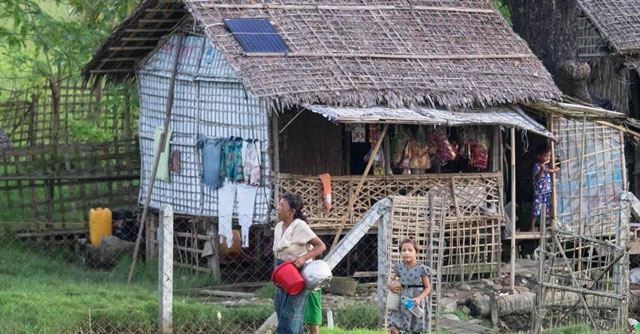
New IRENA brief highlights positive momentum for off-grid renewable energy, and its transformative impact as a key pillar of Sustainable Development Goal 7
Off-grid renewable energy has witnessed spectacular growth over the last decade. Since 2008 capacity has trebled and the number of people in rural communities served by the technology has witnessed six-fold growth. Today, up to 133 million people are receiving life-changing access to low-cost, secure renewable energy and benefit from the socioeconomic impact access delivers. Global off-grid investments in 2017 reached USD 284 million.
These findings feature in a new IRENA brief launched during the UN High-Level Political Forum in New York. The paper, entitled: Off-grid Renewable Energy Solutions, Global and Regional Status and Trends, builds on IRENA’s statistical analysis to offer a global picture of the sector’s trajectory and impact. The data highlights the extent to which off-grid renewables are emerging as a mainstream solution to the expansion of electricity services all over the world, contributing to sustainable development goal 7 (SDG 7) by broadening the reach of electricity beyond existing grid infrastructure.
“Off-grid renewable energy is an important contributor to energy access across the developing world having witnessed widespread, rapid growth in deployment over the last few years,” said Dr. Rabia Ferroukhi, Deputy Director of the Knowledge, Policy and Finance at IRENA. “Our analysis captures this momentum whilst shedding light on the need to step-up efforts towards 2030 Sustainable Development Goals.”
Africa has emerged as a dynamic, fast-moving hub for off-grid renewables. The development of solar lighting solutions and innovations in deployment and financing models, such as pay as you go options and mobile payment platforms have contributed to Africa’s rapid advances. The continent’s off-grid industry now serves around 53 million people – the equivalent of the entire population of South Africa – up from just over two million in 2011. 
The brief identifies Asia as a global leader in off-grid renewables capacity deployment. Today, up to 76 million people across the continent may now benefit from such power sources.
South America, home to some of the highest rates of electricity access in the developing world, has also witnessed off-grid renewable growth the brief suggests, where the technology is considered key to ‘last mile’ electricity access.
Off-grid renewable energy solutions are being deployed to provide electricity services for a wide range of end-uses, including for powering agriculture, telecommunication infrastructure, healthcare centres, schools, and rural enterprises. The paper emphasises that linking delivery of off-grid solutions to energy service delivery can unlock substantial socio-economic benefits, contributing to multiple SDGs.
While dramatic cost reductions have been the primary driver of this acceleration, it is the multifaceted socioeconomic benefits that provide the greatest incentives for its deployment. Renewable energy’s centrality to the SDG 7 goal on universal access to clean, reliable and affordable energy against a backdrop of a billion people who still live without it, is unquestionable. However, beyond energy itself renewables are a key contributor to sustainable development, generating jobs, stimulating growth, ensuring resource security and improving health.
The paper notes that in Bangladesh, around 133 000 jobs have been created through a Solar Home System programme and an off-grid renewables initiative in Rwanda aims to generate 7 000 jobs whilst delivering energy access to almost 80 000 people. Similarly, incomes in rural households benefit from lower cost solar lanterns, and remote health and educational facilities are enhanced through consistent availability of power.
“Renewables are a central pillar of SDG 7 and represent one of the most effective and economic means available in the pursuit of universal energy access,” said Rabia Ferroukhi, Deputy-Director of Knowledge Policy and Finance at IRENA. “Yet beyond this, we are now beginning to truly understand the way in which distributed renewable electricity is transforming the lives of those receiving from it, bringing stability and opportunity to millions of people around the world.”
Read the brief on the Off-grid Renewable Energy Solutions and the six case studies developed to showcase the socioeconomic impact of off-grid renewables in South East Asia.
Source: IRENA
The IEA's World Energy Investment provides a wealth of data and analysis for decision making by governments, the energy industry and financial institutions to set policy frameworks, implement business strategies, finance new projects and develop new technologies. It highlights the ways in which investment decisions taken today are determining how energy supply and demand will unfold tomorrow.
This year's edition points to another year of falling investment in 2017, and that energy investment is failing to keep up with energy security and sustainability goals.
Key Findings:
- For the third consecutive year, global energy investment declined, to USD 1.8 trillion USD in 2017 – a fall of 2% in real terms.
- Falling costs continue to affect investment trends, prices and inter-fuel competition across several parts of the energy sector.
- China remained the largest destination of energy investment, taking over one-fifth of the global total
- There was a pause in the shift of investments towards cleaner sources of energy supply.
- Investment in electrification of transport and heating continued to show exponential growth in 2017, but investments in the direct use of renewables in transport and heat remain weak.
- Spending related to energy efficiency improvements remained relatively immune from the overall downward trend in energy investment worldwide.
- In 2017, green bonds issued primarily for energy efficiency uses exceeded the value of those issued primarily for renewables and other energy uses for the first time.
- The relationship between electricity demand and investment continues to evolve, with the power sector becoming more capital intensive.
- Although it declined by 7%, investment in renewable power, at nearly USD 300 billion, accounted for two-thirds of power generation spending in 2017.
- Robust investment in renewable power is even more important for boosting low-carbon power generation in light of a sharp fall in investment in new nuclear power
- Global spending on the electricity network grew more slowly in 2017, at 1%, to top USD 300 billion.
- Investment in fossil fuel supply stabilized around USD 790 billion in 2017 as reduced spending in coal supply and in liquefied natural gas (LNG) offset a modest rise in upstream oil and gas.
- The oil and gas industry is shifting towards short-cycle projects and rapidly declining producing assets while expanding into the downstream sector and petrochemicals.
- Higher prices and operational improvements are putting the US shale sector on track to achieve positive free cash flow in 2018 for the first time ever.
- The rollercoaster journey of oil prices in recent years has not fundamentally changed the way the oil and gas industry finance its operations.
- While corporations continue to provide the bulk of primary finance for energy investments, there are signs of diversification of financing options in some sectors.
- The share of private-led energy investment has declined in the past five years.
- Investment decisions in some sectors are increasingly affected by government policies.
- Government energy research and development (R&D) spending increased by around 8% in 2017, reaching a new high of USD 27 billion.
- New approaches to boosting investment in carbon capture, utilization and storage (CCUS) are needed for the world to be on track to meet its climate change goals.
- Electric batteries are increasingly being deployed across the energy sector, but their impact will largely depend on cost trends, which will be strongly influenced by investments outside the energy sector.
Please click here to read the full report.
Agenda
Global Power & Energy Exhibition 2018
September 17 – 20 / Barcelona, Spain
Global District Energy Days
September 25 - 27 / Helsinki, Finland
Global Wind Summit
September 25 – 28 / Hamburg, Germany
11th International Conference on Energy and Climate Change
October 10 – 12 / Athens, Greece
